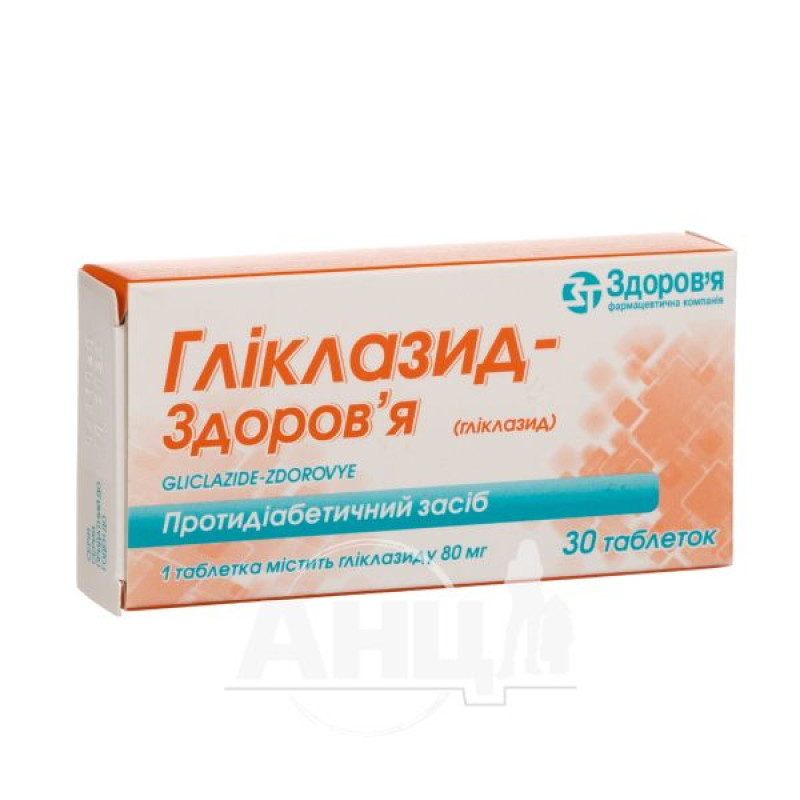Gliclazide-Health tablets 80 mg blister No. 30

Pharmacological properties
Gliclazide (1-(3-aza-bi-cyclo[3,3,0]octyl-3)-3-(para-tolylsulfonyl)urea) is an oral hypoglycemic agent, a second-generation sulfonylurea derivative. Stimulates insulin secretion by pancreatic β-cells, which is accompanied by mobilization and increased release of endogenous insulin. Potentiates the insulin-secretory effect of glucose. Increases tissue sensitivity to insulin by increasing the number of insulin-sensitive receptors on target cells. Has an antioxidant effect, reduces platelet aggregation, normalizes vascular permeability, prevents the development of microthrombosis and atherosclerosis, helps prevent microcirculatory disorders, including diabetic retinopathy, increases fibrinolytic activity of the blood. In diabetic nephropathy, it helps reduce proteinuria and normalize the level of uric acid. In obese patients, when following an appropriate diet, it promotes weight loss. The hypoglycemic effect develops gradually. When prescribing the drug, the interval between eating and the beginning of insulin secretion is shortened. Gliclazide restores the early peak of insulin secretion and reduces the postprandial peak of hyperglycemia.
The drug is rapidly and completely absorbed from the gastrointestinal tract. The maximum concentration in the blood serum is reached 4 hours after a single dose of 80 mg. The equilibrium concentration in the blood plasma is reached after 2 days. Binding to plasma proteins is 85-99%. The half-life is 12 hours, which allows taking the drug 2 times a day. It is excreted by the kidneys (65% - in the form of metabolites, less than 1% - in unchanged form) and through the intestines (12%).
Indication
Non-insulin-dependent diabetes mellitus (type II) of moderate severity with initial manifestations of diabetic microangiopathy. Prevention of microcirculatory disorders (in combination therapy with other sulfonylurea derivatives).
Application
Take 0.5-1 hour before meals. Usually prescribed 80 mg 2 times a day. For mild diabetes mellitus, 80 mg can be prescribed once a day, for severe diabetes - 240 mg/day. The maximum daily dose is 0.24-0.32 g.
Contraindication
Hypersensitivity to sulfonylurea derivatives, insulin-dependent diabetes mellitus in adolescence, ketoacidosis, diabetic precoma and coma, severe renal and hepatic insufficiency, major injuries and burns, hypo- and hyperthyroidism, pregnancy and breastfeeding, childhood (efficacy and safety of the drug have not been established).
Side effects
Hypoglycemia, allergic reactions (skin itching, urticaria, photosensitivity), dyspeptic phenomena (nausea, vomiting, stomach pain, constipation), extremely rarely - jaundice, reversible thrombocytopenia, agranulocytosis or leukopenia, anemia, weakness, headache, dizziness, taste disturbance.
Special instructions
Gliclazide-health should be taken on the background of a low-calorie diet with a low carbohydrate content. During the period of dose selection, it is necessary to determine the glycemic profile, and subsequently - regular monitoring of blood glucose levels. To prevent hypoglycemia, the drug should be taken with meals. You should avoid fasting and completely abandon alcohol consumption. Simultaneous treatment with b-adrenergic blockers can mask the symptoms of hypoglycemia. During surgical interventions or diabetes in the decompensation phase, the possibility of using insulin preparations should be taken into account. In case of clinical signs of hypoglycemia (increased sweating, pale skin, tachycardia, general malaise), the dose of the drug should be adjusted. Use with caution in drivers of motor vehicles and people whose professional activities require increased concentration.
Interactions
The hypoglycemic effect of gliclazide is potentiated by NSAIDs (especially salicylates), sulfonamides, indirect anticoagulants, MAO inhibitors, b-adrenergic blockers, ACE inhibitors, anabolic steroids, diazepam, tetracyclines, chloramphenicol, ethanol-containing drugs. The effectiveness of the drug is reduced when used simultaneously with barbiturates, chlorpromazine, sympathomimetics, glucagon, corticosteroids, saluretics, rifampicin, thyroid hormones, lithium salts, high doses of nicotinic acid, oral contraceptives and estrogens. Compatible with biguanides. Incompatible with miconazole.
Overdose
Hypoglycemic state, coma, cerebral edema. In the event of hypoglycemia, if the patient is conscious, glucose or a sugar solution is administered orally. In the event of loss of consciousness, glucose is administered intravenously, glucagon subcutaneously, intramuscularly or intravenously. After regaining consciousness, the patient must be given food rich in carbohydrates to avoid recurrence of hypoglycemia. In the event of cerebral edema, mannitol and dexamethasone are administered intravenously.
Storage conditions
In a dry, dark place at a temperature not exceeding 25 °C.
There are no reviews for this product.
There are no reviews for this product, be the first to leave your review.
No questions about this product, be the first and ask your question.



